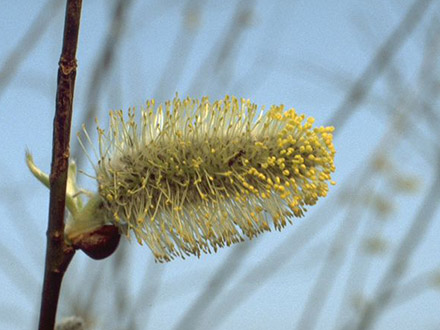Botanical name
Willow - Salix L.
Family
Willow family (Salicaceae)
Common name
White willow (Salix alba L.)
Information about the plant
The genus Salix L. (Willow) is represented from the Arctic to the temperate zones in the tropics with approximately 500 species and grows from the seacoast to alpine regions. Approximately 35 species are native to Central Europe, they tolerate constantly wet ground and are therefore, often the basic makeup of shoreline bushes and floodplain forests. Some willows are trimmed as "pollard willow" every two to three years from the branches, which are then woven into baskets.
Multiple salicylate-rich species are used medicinally, primarily the Purple willow or Purple osier (Salix purpurea L.), Daphne willow or Violet willow (Salix daphnoides Vill.) and Crack willow (Salix fragilis L.). Other willow species can be used as a source plant when its bark meets the qualitative requirements for the ingredients (salicylates). Possible examples are the Bay willow (Salix pentandra L.), the Dwarf willow (Salix herbacea L.), and the Blunt-leaved willow (Salix retusa L.).
Willows are 6 to 10 m high trees or shrubs with spirally arranged, sometimes silvery, oblong leaves, that are usually hairy on the underside and often turn black when drying. Willows are dioecious, meaning that the male and female flowers grow on different trees. They usually bloom in spring before the leaves sprout. The flowers are united in catkin-shaped inflorescences, which often bloom on Palm Sunday (the Sunday before Easter), which is why they are popularly known as "palm catkins". The female catkins are greenish, the male catkins have protruding yellow stamens. The nectar of flowering willows is the first food for bees in spring.
Medicinally used parts of plants (herbal drug)
The dried bark of young branches in their second or third year, and young twigs in their first year (willow bark - Salicis cortex) are used. The commercially available drug comes mainly from Bulgaria, Hungary, and Romania.
Constituents of the herbal drug
Willow bark contains salicylic acid derivatives (salicylates), caffeic acid derivatives, and flavonoids.
Quality of the drug
The quality of the following drugs or drug preparations is specified in the European Pharmacopoeia (Ph. Eur.):
- Willow bark (Salicis cortex)
- Willow bark dried extract (Salicis corticis extractum siccum)
Medical applications
Recognised medical use
The HMPC has accepted quantified willow bark dry extracts (DER 8-14:1, solvent ethanol 70%, 15% total salicylic derivatives) as "well-established use" for the short-term treatment of mild back pain; see also "Traditional use".
ESCOP: for mild back pain and mild rheumatic complaints; also, for feverish colds and headaches. These applications are based upon long-standing use.
Traditional use
Non-quantified willow bark preparations (dry extract, liquid extract, tincture), including willow bark powder and cut willow bark, have been classified by the HMPC as traditional herbal medicinal products (Article 16a of Directive 2001/83/EC). Based upon long-standing use, unquantified willow bark preparations can be used for relief of minor joint pain, relief of fever linked with the common cold and for headaches.
Herbal drug preparations in finished dosage forms
- Chopped or coarsely powdered willow bark as a tea
- Dried extracts in capsules and tablets
- Tincture in drops
Dosage
Prepared drugs: To ensure the effect, the willow bark must be taken in the form of a finished medicinal product with a defined potency (quantified extract), the dosage is specified in the patient information leaflet. The recommended daily dose in terms of the salicylic derivatives (salicylates) is 120 to 240 mg.
Tea: drink a cup of willow bark tea (rheumatism tea) 3 to 4 times daily; average daily dose for adults is 4 to 12g of the drug.
Preparation of a tea
Mix 2-3 g of finely chopped or coarsely powdered willow bark with 150ml of cold water, bring the mixture to the boil, remove from heat, and strain after 10 minutes.
Notes
People with hypersensitivity to salicylates (e.g. aspirin) and other anti-inflammatory drugs, as well as those who are prone to allergies should not take willow bark. Patients with asthma, gastrointestinal ulcers, and renal or liver function should only use it after consulting a doctor. It is not recommended to use willow bark during pregnancy and lactation because salicylates cross the placenta and appear in breast milk. It is also not recommended for use in children and adolescents under the age of 18 years due to a lack of evidence.
Side effects
The use of willow bark has resulted in the occasional stomach discomfort.
Occasionally, hypersensitivity reactions of the skin can occur.
Interactions
The effect of anticoagulant drugs may increase, and the effect of drugs to increase uric acid excretion may be reduced.
References
Herbal drug monographs
HMPC (2017), ESCOP (2017), WHO Vol. 4
Further literature
Commentary on the European Pharmacopoeia (Willow bark, no. 1583; Willow bark dried extract, no. 2312)


